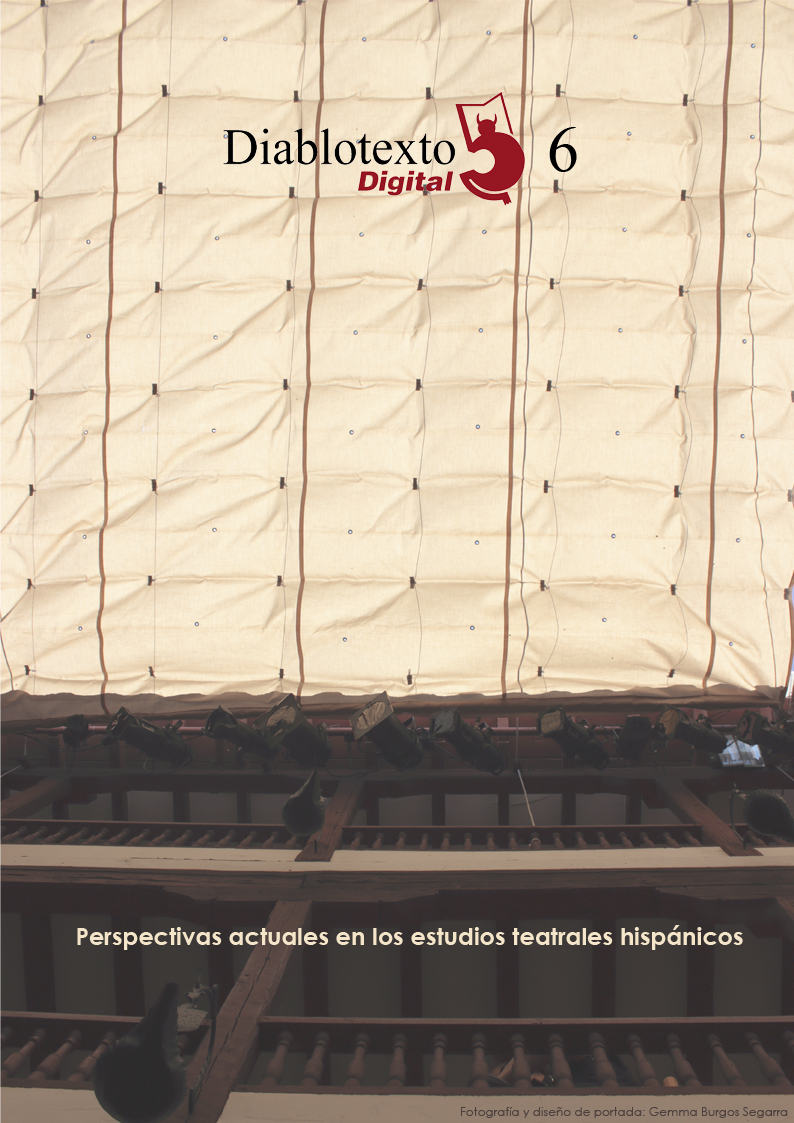Golden-age drama on contemporary stage: the role of lighting and music in El Caballero de Olmedo
DOI:
https://doi.org/10.7203/diablotexto.6.16716Keywords:
El Caballero de Olmedo, theatre reception, lighting, music Abstract
Abstract
The following analysis aims to study the role of lighting and music in contemporary performances of Golden-age drama through some contemporary adaptations of El Caballero de Olmedo by Lope de Vega performed in Spain between
1982 and 2014. The analysis presents the strong connection between what takes place on stage and the use of lighting and music. Far from being disturbing elements in a kind of plays typically devoted to words, as Golden age dramas are, in fact, lighting and music can make Lope’s verses shine –if properly used.
 Downloads
Downloads
 References
References
Antonucci, Fausta (2009). “Notas sobre la función estructural y semántica de la métrica y del espacio en El Caballero de Olmedo, de Lope de Vega”. En Joaquín Álvarez Barrientos, Oscar Cornago Bernal, Abraham Madroñal Durán, Carmen
Menéndez-Onrubia (eds.), En buena compañía. Estudios en honor de Luciano García Lorenzo. Madrid: Consejo Superior de Investigaciones Científicas, pp. 49-57.
Bravo, Julio (2014). “El caballero de Olmedo, cocina de autor para Lope de Vega”, ABC, 07/02/2014. Díez Borque, José María (1975).”Aproximación semiológica a la “escena” del teatro del Siglo de Oro español”. En José Ma Díez Borque, Luciano García Lorenzo (eds.), Semiología del teatro. Barcelona: Planeta, pp. 49-92.
García Lorenzo, Luciano (2007). Las puestas en escena de “El Caballero de Olmedo”. Olmedo: Olmedo Clásico. Huélamo Kosma, Julio (2019). “Alcance epistemológico del teatro filmado: un esbozo de análisis sobre algunas puestas en escena de La casa de Bernarda Alba”. En Guillermo Laín Corona y Rocío Santiago Nogales (eds.), Cartografía teatrale en homenaje al profesor José Romera Castillo. Madrid: Visor Libros, Tomo II, pp.391-407.
Iglesias Simón, Pablo (2016). “El espacio sonoro y el diseñador de sonido: arte y oficio”. En José Romera Castillo (ed.), Teatro y música en los inicios del siglo XXI. Madrid: Editorial Verbum, pp. 80-101.
Mascarell, Purificación (2013). “El caballero de Olmedo en la Compañía Nacional de Teatro Clásico”. En Alain Bègue, Emma Herrán Alonso (eds.), Pictavia aurea: actas del IX congreso de la Asociación internacional “Siglo de Oro“ (Poitiers, 11-15 de julio de 2011), pp. 963-971.
Moreno Pachón, Susana (2004). “Un caballero de Olmedo lleno de tensión y suspense llega al Pavón”,El País, 04/02/2004 http://elpais.com/diario/2004/02/04/madrid/1075897476_850215.html [consultado el 4 de octubre de 2019].
Ordóñez, Marcos (2014). “Bulería y luna de Olmedo”, El País, 22/04/2014. Pavis, Patrice (1980). Dictionnaire du Théâtre. Paris: Éditions Sociales.
Pavis, Patrice (2004). L’analisi degli spettacoli. Teatro, mimo, danza. Teatro-danza, cinema. Trad.it. di Dario Buzzolan e Roberta Cortese. Torino: Lindau.
Ruano de la Haza, José (2001). “Los investigadores modernos y la puesta en escena del teatro clásico”. En Irene Pardo Molina, Antonio Serrano Agulló (eds.), En torno al teatro del Siglo de Oro. XV Jornadas de Teatro del Siglo de Oro. [Almería, del 5 al 15 de marzo de 1998]. Almería: Instituto de Estudios Almerienses, pp. 201-210.
Rubiera Fernández, Javier (2005). La construcción del espacio en la comedia española del Siglo de Oro. Madrid: Arco/Libros, S.L.
Vega, Lope (de) (2002). El Caballero de Olmedo: edición de Francisco Rico. Alicante: Biblioteca Virtual Miguel de Cervantes.
Wheeler, Duncan, (2012). Golden age drama in contemporary Spain: the comedia on page, stage and screen. Cardiff: University of Wales Press.
Downloads
Published
How to Cite
-
Abstract467
-
PDF (Español)356
Issue
Section
License
Licencia de reconocimiento de Creative Commons “Reconocimiento - No Comercia l- Sin Obra Derivada
Authors who publish with this journal agree to the following items:
The authors will keep their copyright and guarantee the journal the right of first publication of their work, which will be simultaneously subject to the Creative Commons license that allows third parties to share the work indicating its author and its first publication in the journal. The authors may adopt other non-exclusive license agreements to distribute the version of the published work (e.g., depositing it in an institutional telematic file or publishing it in a monographic volume), with an acknowledgment of its initial publication in this journal. The authors are allowed and encouraged to disseminate their work through the Internet (e.g., in institutional telematic archives or on their website) before and during the submission process, which can produce interesting exchanges and increase citations of the published work. (See Effect of Open Access)




